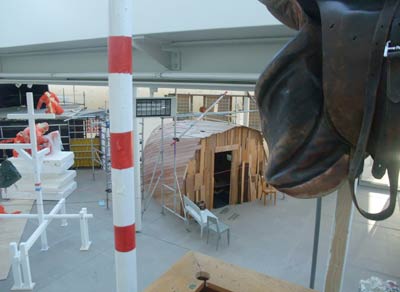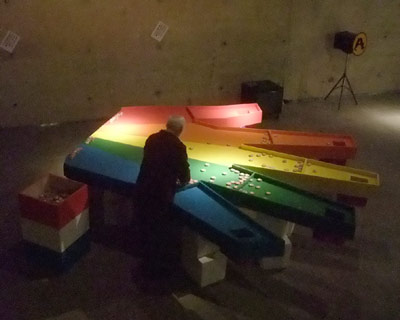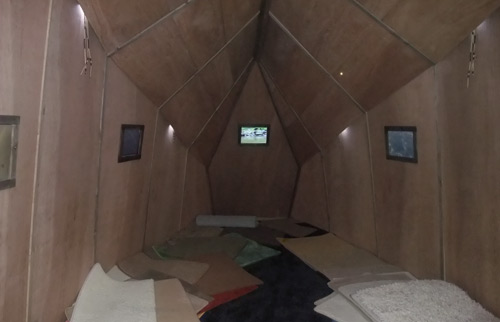![]() Other work by Sen + Sonja About Sonja's work in this exhibition Sonja's Texts Page Sonja's c.v. page
Other work by Sen + Sonja About Sonja's work in this exhibition Sonja's Texts Page Sonja's c.v. page
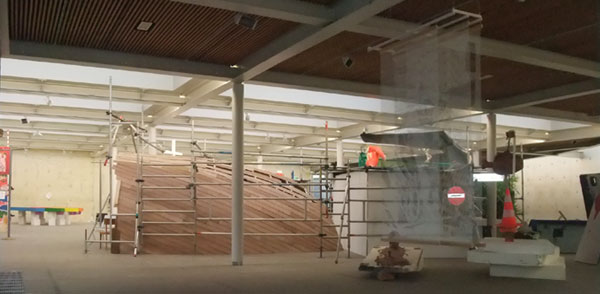
Left to Right: Detail of David Bade's Poeperij, (far wall left)
Bestemming onbekend (Destination unknown) by Rudi Struik (coloured table-like object)
Kāinga a roto (Home within) (boat form) by Sonja van Kerkhoff
Details of works by David Bade (orange above + forms on the ground, fore)
(hang lattice in the foreground) Afschied van Nederland by Rudi Struik
(road sign) detail of de verstoten hoek (The rejected corner) by Dirk de Bruyn
(plants) detail of an installation by Renée Ridgway
See the Museum Beelden aan Zee website for details of the Public programme.
Next events:
2 Feb, 19:30
screening of 4 films by Sonja, 7.30 - 8.45 p.m.
Visit the show until 9.30 p.m. All-in entry fee: 5 Euros.
9 Feb: lezing door Prof. Kitty Zijlmans, 19uur.
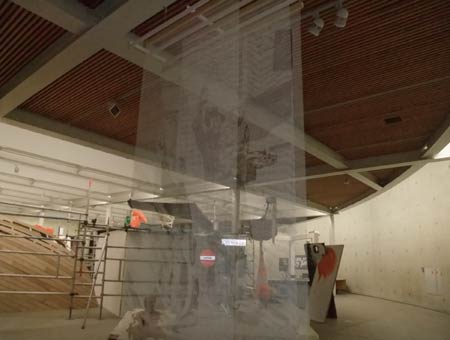
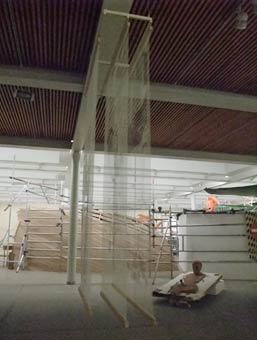

Views of Afschied van Nederland (Leaving Holland) by Rudi Struik
with sculpture by David Bade on the right.
Rudi Struik's "Afschied van Nederland" (Leaving Holland) is matter of fact, we see an image -faded by layering. A snapshot, the last snapshot, of a family about to immigrate. It is his story, he is the child in the family, and as is the case with any personal story you some familiarity in order to see the detail. Move a little and the detail changes. The layers are the means for revelation and yet the distances between them are reminders that nostaglia is memory faded, memory coloured by a changing world.
In stark contrast David Bade's 'city' sculptures are like naked truths of an unsentimental here and now. Their materiality evokes a sense of decay and rejection, of material unwanted, but on closer examination each work is a celebration of life. A 'want' of the here and now, but with a playful twist.

Three Sculptures by David Bade with a wall of the
Verstoten Hoek (Rejected corner)
by Dirk de Bruyn on the left.
<< Detail of one of these three sculptures by David Bade.
The figure on the ground seems to be engaged in navel gazing, except that his erect penis is a joystick which protrudes from a mud-like ooze, and in fact his body seems about to spill off the edge. In the sculpture adjacent to this a kitchen roll functions as a flag perched from a totem pole-like stack of mismatches: slabs of rejected polystyrene, a roadworks cone, bits of wire, a moulded head with a glove protruding from it.
The flimsy construction is both humourous and inventive while reminiscent of some of Carel Visser's public sculptures which incorporate a gymnastics of balanced figurations and abstractions.


In another of Bade's sculptures, two doors are leaning against each other and where the doors interlock, two heads are painted as if kissing -reminding me of Rodin's The Kiss...

Foreground: Installation, the Verstoten Hoek by Dirk de Bruyn
... a moment of passion, here created out of what looks like rubble.
On the reverse one slab sports a painting of a red devil and the other has the text "Here rests God" gouged out of the veneer of black - two unwanteds in this context - a dead God and a living devil. Or that God is dead and the devil is living, or that there is always both, good and bad, want and unwant, or is it perhaps a reminder of desire and rejection?
Dirk de Bruyn's "De Verstoten Hoek" (The Rejected Corner), a black walled space lined with "caution" tape, initially seems to be about rejection. Every so often someone crying can be heard from one of the videos, visible only through a narrow slot inside a no-entry traffic sign.

Detail of the installation, the Verstoten Hoek by Dirk de Bruyn
Four tables display letters written in Dutch by children to him as an eight year old. When you begin to read them it seems that the work is more about the time frame of 1958, when he immigrated with his parents to Australia. The letters, texts and objects are testimonies and in a sense a tableau or 'offerings' of this event, via the voices of the children, the toys, the suitcase and the scribbled texts on the blackboard. He gives this event further emphasis with a placard, gold lettering against green, stating that Dico de Bruijn disappeared on the date that he left the Netherlands.
It signifies the death of his dutchness, a dramatic break as it must have felt to the eight year old who was suddenly thrown into a new world.

Settlements (white cube form on wheels) by Tiong Ang.
Tiong Ang's childhood is similiar, he immigrated to the Netherlands as a five year old from Indonesia but he has approached the theme of the show from a more conceptual perspective. His work, "Settlements", a cube form inspired by Sol De Wit's 1967 work the Open Cube, functions as a podium, as a land literally on the move. The 3 square metre stage is not only the site for various performances by actors and the public during this exhibition, but also in being moved around in the exhibition space its mobility as well as its framing of space ...to be continued...


